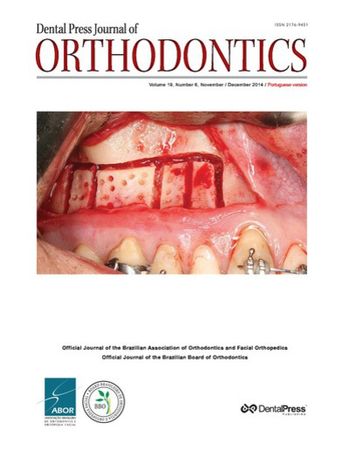3D Orthodontics – from Verne to Shaw
As children receiving new toys, we are approaching a great new world of fantasy. Three-dimensional image devices arrived at the port of Orthodontics with increasingly strong anchors firmly holding to the ground. In this case, immobility is symbolical and inversely proportional to the ongoing...
Autores: David Normando,
messages.RevistaAutores:
LEIA MAIS
How can I explore high-dimensional data?
High-dimensional data hinder sample visualization and limit exploration of data1. In these cases, we can make use of multivariate analysis techniques, such as Factor Analysis (FA) and/or Principal Component Analysis (PCA), to reduce a complex data set to one of lower dimensions so as to reveal...
Autores: David Normando, Giseon Heo, Glaucia Cristina Rodrigues Nascimento, Marcela Baraúna Magno,
messages.RevistaAutores:
LEIA MAIS
orthodontics highlights
for the orthodontist. Which orthodontist has never had the displeasure of assessing a case over the retention phase and finding out that formerly well-positioned teeth are now rotated or have diastema? In the attempt to prevent relapse, the orthodontic literature recommends that retention,...
Autores: Matheus Melo Pithon,
messages.RevistaAutores:
LEIA MAIS
The clinical meaning of external cervical resorption in maxillary canine: transoperative dental trauma
External Cervical Resorption in maxillary canines with pulp vitality is frequently associated with dental trauma resulting from surgical procedures carried out to prepare the teeth for further orthodontic traction. Preparation procedures might surgically manipulate the cementoenamel junction or...
Autores: Alberto Consolaro, Mauricio De Almeida Cardoso, Leopoldino Capelloza Filho, Carolina Dornelas C. M. De Almeida, Ingrid Araújo Oliveira Souza,
messages.RevistaAutores: External cervical resorption, Dental trauma, Orthodontic traction, Alveolodental luxation,
LEIA MAIS
An interview with Peter H. Buschang
Dr. Peter Buschang is regent professor and director of orthodontic research. He has been at Texas A&M University Baylor College of Dentistry since 1988. Dr. Buschang received his PhD in 1980 from the University of Texas at Austin; he spent 3 years as a NIDR postdoctoral fellow at the University...
Autores: Luiz Gonzaga Gandini Júnior, Ary Dos Santos-Pinto, Gerson Luiz Ulema Ribeiro, Eustáquio Araújo, Helder Baldi Jacob,
messages.RevistaAutores:
LEIA MAIS
Orthodontic treatment in a patient with unilateral open-bite and Becker muscular dystrophy. A 5-year follow-up
Introduction: Becker muscular dystrophy is an X-chromosomal linked anomaly characterized by progressive muscle wear and weakness. This case report shows the orthodontic treatment of a Becker muscular dystrophy patient with unilateral open bite. Methods: To correct patient’s malocclusion,...
Autores: Juan Fernando Aristizabal, Rosana Martínez Smit,
messages.RevistaAutores: Corrective Orthodontics, Open bite, Muscular dystrophies,
LEIA MAIS
Björk-Jarabak cephalometric analysis on CBCT synthesized cephalograms with different dentofacial sagittal skeletal patterns
Objective: The objective of this study was to evaluate the Björk and Jabarak cephalometric analysis generated from conebeam computed tomography (CBCT) synthesized lateral cephalograms in adults with different sagittal skeletal patterns. Methods: The sample consisted of 46 CBCT synthesized...
Autores: Carlos Flores Mir, Yalil Augusto Rodriguez Cardenas, Luis Ernesto Arriola Guillen,
messages.RevistaAutores: Malocclusion, Cephalometry, Computed tomography scanners,
LEIA MAIS
Prevalence of sleep bruxism in children: A systematic review
Introduction: Prevalence of sleep bruxism (SB) in children is subject to discussions in the literature. Objective: This study is a systematic literature review aiming to critically assess the prevalence of SB in children. Methods: Survey using the following research databases: MEDLINE, Cochrane,...
Autores: Cibele Dal-Fabbro, Eduardo Machado, Paulo Afonso Cunali, Osvaldo Bazzan Kaizer,
messages.RevistaAutores: Child, Bruxism, Prevalence, Sleep bruxism,
LEIA MAIS
Protein biomarkers of external root resorption: A new protein extraction protocol. Are we going in the right direction?
Objective: The aim of this study is to determine a protocol of gingival crevicular fluid protein extraction used for the first dimension of 2-DE gels. It also aims at conducting a review on the current candidates for protein markers of this pathology, all of which may be used to prevent the...
Autores: Giovanni Modesto,
messages.RevistaAutores: Root resorption, gingival crevicular fluid, Molecular diagnosis technique, Electrophoresis, Isoelectric focusing,
LEIA MAIS
Longitudinal stability of rapid and slow maxillary expansion
Objective: The aim of this retrospective study was to compare the longitudinal stability of two types of posterior crossbite correction: rapid maxillary expansion (RME) and slow maxillary expansion (SME). Methods: Study casts of 90 adolescent patients were assessed for interdental width changes...
Autores: Marcos Roberto De Freitas, Fábio Henrique De Sá Leitão Pinheiro, Guilherme Janson, Roberto Bombonatti, Daniela Gamba Garib,
messages.RevistaAutores: Palatal Expansion Technique, Orthodontics, Treatment outcomes,
LEIA MAIS
The use of three-dimensional cephalometric references in dentoskeletal symmetry diagnosis
Objective: The aim of this study is to assess dentoskeletal symmetry in cone-beam computed tomography (CBCT) scans of Brazilian individuals with Angle Class I malocclusion. Material: A total of 47 patients (22 females and 25 males) aged between 11 and 16 years old (14 years) seen in a private...
Autores: Carlos Estrela, Jairo Curado De Freitas, Olavo Cesar Lyra Porto, Ana Helena Gonçalves De Alencar,
messages.RevistaAutores: cone-beam computed tomography, Facial asymmetry, Three-dimensional imaging,
LEIA MAIS
Information available on the internet about pain after orthognathic surgery: A careful review
Objective: Investigate the quality of data available on the internet with respect to pain after orthognathic surgery. Methods: A careful search was conducted on the Internet in December, 2012. The most accessed websites browsers were employed for research using the terms: “pain” and...
Autores: Matheus Melo Pithon, Elinailton Silva Dos Santos,
messages.RevistaAutores: internet, Orthognathic surgery, Pain, Information,
LEIA MAIS
The effects of binge-pattern alcohol consumption on orthodontic tooth movement
Objective: This study aimed to assess tissue changes during orthodontic movement after binge-pattern ethanol 20% exposure. Methods: Male Wistar rats (n = 54) were divided into two groups. The control group (CG) received 0.9% saline solution, while the experimental group (EG) received 20% ethanol...
Autores: Elisa Souza Camargo, Orlando Motohiro Tanaka, Cristiano Miranda De Araujo, Aline Cristina Batista Rodrigues Johann,
messages.RevistaAutores: Tooth movement, Orthodontics, Bone remodeling,
LEIA MAIS
Second molar impaction associated with lip bumper therapy
Introduction: Although lip bumpers (LBs) provide significant clinical gain of mandibular arch perimeter in mixeddentition patients, orthodontists are reluctant to use them due to the possibility of permanent second molar eruptive disturbances. Objective: The present study was conducted to assess...
Autores: Peter H. Buschang, Helder Baldi Jacob, Richard G. Alexander, Shawn LeMert,
messages.RevistaAutores: Interceptive orthodontics, Unerupted tooth, Impacted tooth, Molar tooth,
LEIA MAIS
Effect of adhesive remnant removal on enamel topography after bracket debonding
Introduction: At orthodontic treatment completion, knowledge about the effects of adhesive remnant removal on enamel is paramount. Objective: This study aimed at assessing the effect of different adhesive remnant removal methods on enamel topography (ESI) and surface roughness (Ra) after bracket...
Autores: Américo Bortolazzo Correr, Mário Vedovello Filho, Heloísa Cristina Valdrighi, Larissa Adrian Meira Cardoso,
messages.RevistaAutores: Orthodontic brackets, Dental enamel, Device removal,
LEIA MAIS
Class II malocclusion nonextraction treatment with growth control*
The present study reports a case of Angle Class II malocclusion treatment of a male growing patient with 10-mm overjet, excessive overbite and transverse maxillary deficiency. The case was presented to the Brazilian Board of Orthodontics and Dentofacial Orthopedics (BBO), with DI equal to or...
Autores: Zilda Lúcia Valentim Assunção,
messages.RevistaAutores: Palatal Expansion Technique, Angle Class III malocclusion, Growth and development,
LEIA MAIS
New therapeutic modalities to modulate orthodontic tooth movement
Modulation of orthodontic tooth movement (OTM) is desirable not only to patients because it shortens treatment time, but also to orthodontists, since treatment duration is associated with increased risk of gingival inflammation, decalcification, dental caries, and root resorption. The increased...
Autores: Ildeu Andrade Jr, Ana Beatriz Dos Santos Sousa, Gabriela Gonçalves Da Silva,
messages.RevistaAutores: Ultrasound, Orthodontic tooth movement, Corticotomy surgery, Gene therapy,
LEIA MAIS



